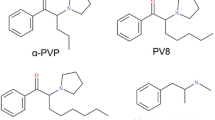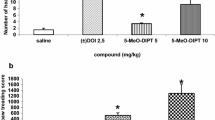Abstract
Circadian fluctuations were measured in the head twitch response produced by 5-methoxy-N1,N1-dimethyltryptamine (5-MeODMT) and p-chloroamphetamine (PCA) in male BK. TO mice. The effects of depleting brain 5-hydroxytryptamine (5-HT) with p-chlorophenylalanine (PCPA) on the 5-MeODMT in the mouse were also studied. Changes in brain 5-HT and 5-hydroxyindoleacetic (5-HIAA) were concomitantly determined. PCPA (400 mg/kg IP twice on consecutive days) significantly increased the number of head twitches induced by 5-MeODMT (5 mg/kg IV) on days 3 and 5 after the initial injection of PCPA when 5-HT and 5-HIAA were also significantly reduced. On day 12, there was no significant difference in the number of head twitches between mice administered PCPA and those given saline, and 5-HT and 5-HIAA levels were nearly back to normal. PCPA, using the same dose schedule, significantly reduced the number of head twitches induced by PCA when PCA was administered 24h after the second injection of PCPA (day 3). Mice maintained on a 12-h light-dark cycle showed a maximum response to the direct 5-HT receptor agonist 5-MeODMT (5 mg/kg IV) towards the end of the dark period, when the 5-HT level was at its lowest. p-Chloroamphetamine, which causes release of 5-HT from pre-synaptic neurones, produced a peak head twitch response in the middle of the light period when 5-HT and 5-HIAA levels were maximal, while the response towards the end of the dark period was significantly less than that at other tines tested. It is concluded that 5-HT receptor response shows a circadian rhythm related to both pre-synaptic availability of 5-HT and post-synaptic receptor sensitivity.
Similar content being viewed by others
References
Bornschein RL, Crockett RS, Smith RP (1977) Diurnal variations in the analgesic effectiveness or morphine in mice. Pharmacol Biochem Behav 6:621–626
Corne SJ, Pickering RW, Warner BT (1963) A method for assessing the effects of drugs on the central actions of 5-hydroxytryptamine. Br J Pharmacol 20:106–120
Curzon G, Green AR (1970) Rapid method for the determination of 5-hydroxytryptamine and 5-hydroxyindoleacetic acid in small regions of rat brain. Br J Pharmacol 39:653–655
Curzon G, Fernando JCR, Marsden CA (1978) 5-hydroxytryptamine: The effects of impaired synthesis on its metabolism and release in rat. Br J Pharmacol 63:627–634
Frederickson RCA, Burgis V, Edwards JD (1977) Hyperalgesia induced by haloxone follows diurnal rhythm in responsivity to painful stimuli. Science 198:756–758
Héry F, Chouvet G, Kan JP, Pujol JF, Glowinski J (1977) Daily variations in various parameters of serotonin metabolism in the rat brain. II. Circadian variations in serum and cerebral tryptophan levels: Lack of correlation with 5-HT turnover. Brain Res 123:137–145
Kan JP, Chouvet G, Héry F, Debilly G, Mermet A, Pujol JF (1977) Daily variations in various parameters of serotonin metabolism in the rat brain. I. Daily variations of tryptophan-5-hydroxylase in the raphe nuclei and the striatum of the rat brain. Brain Res 123:125–136
Koe BK, Weissman A (1966) p-Chlorophenylalanine (PCPA): A specific depletor of brain serotonin. J Pharmacol Exp Ther 154:499–516
Marsden CA, King B (1979) The use of Doppler shift radar to monitor physiological and drug-induced activity patterns in the rat. Pharmacol Biochem Behav 10:631–635
Marsden CA, Conti J, Strope E, Curzon G, Adams RN (1979) Monitoring 5-hydroxytryptamine release in the brain of the freely moving unanaesthetised rat using in vivo voltammetry. Brain Res 171:85–99
Marsden CA, Bennett GW, Brazell M, Sharp T, Stolz JF (1981) Electrochemical monitoring of 5-hydroxytryptamine release in vitro and related in vivo measurements of indoleamines. J Physiol (Paris), in press
Morgan WW, Yudo CA, McFadin LS (1974) Daily rhythmic changes in the content of serotonin and 5-hydroxyindoleacetic acid in the cerebral cortex of mice. Life Sci 14:329–338
Morgan WW, Pfeil KA, Reiter RJ, Gonzales E (1976) Comparison of changes in tryptophan and serotonin in regions of the hamster and the rat brain over a twenty-four hour period. Brain Res 117:77–84
de Montigny C, Aghajanian GK (1977) Preferential action of 5-methoxytryptamine and 5-MeODMT on pre-synaptic serotonin receptors: A comparative iontophonetic study with LSD and serotonin. Neuropharmacology 16:811–818
Nagayama H, Takagi A, Tateishi T, Takahasi R (1977) Circadian susceptibility rhythm to neuroleptics: Tetrabenazine. Psychopharmacology 55:61–66
Nagayama H, Takagi A, Sakurai S, Yoshimoto K, Nishiwaki K, Takahashi R (1979) Chronopharmacological study of neuroleptics. III. Circadian rhythm of brain susceptibility to haloperidol. Psychopharmacology 63:131–135
Nakamura M, Fukushima H, Kitagawa S (1976) Effects of amitryptyline and isocarboxazid on 5-hydroxytryptophan-induced head twitches in mice. Psychopharmacology 48:101–104
Nakamura M, Fukushima H (1978) Effects of reserpine, parachlorophenylalanine, 5,6-DHT and fludiazepam on the headtwitches induced by 5HT or 5MT in mice. J Pharm Pharmacol 30:377–394
Samanin R, Mennini T, Ferraris A, Bendotti C, Borsini F (1980) Hyper- and hyposensitivity of central serotonin receptors: 3H-Serotonin binding and functional studies in the rat. Brain Res 189:449–457
Sanders-Bush E, Massari VJ (1977) Action of drugs that deplete serotonin. Fed Proc 36:2149–2153
Savage DD, Mendels J, Frazer A (1980) Decrease in 3H-Serotonin binding in rat brain produced by repeated administration of either monoamine oxidase inhibitors or centrally acting serotonin agonists. Neuropharmacology 19:1063–1970
Singleton C, Marsden CA (1979) Increased responsiveness to 5-methoxy-N1,N1-dimethyltryptamine in mice on a high tryptophan diet. Neuropharmacology 18:569–572
Steigard P, Tobler I, Waser PG, Borbely AA (1978) Effect of p-chlorophenylalanine on cerebral serotonin binding, serotonin concentration and motor activity in the rat. Naunyn-Schmiedeberg's Arch Pharmacol 305:143–148
Stewart RM, Growdon JH, Cancian D, Baldessarini RJ (1976) 5-Hydroxytryptophan-induced myoclonus: Increased sensitivity to serotonin after intracranial 5,7-dihydroxytryptamine in the adult rat. Neuropharmacology 15:449–455
Tapp WN, Holloway FA (1979) Circadian variations in the effect of α-methyl-p-tyrosine on avoidance learning. Psychopharmacology 68:193–194
Trulson ME, Jacobs BL (1976) Behavioural evidence for the rapid release of CNS serotonin by PCA and fenfluramine. Eur J Pharmacol 36:149–154
Trulson ME, Jacobs BL (1979) Effects of 5-methoxy-N1,N1-dimethyltryptamine on behaviour and raphe unit activity in the freely moving cat. Eur J Pharmacol 54:43–50
Trulson ME, Eubanks EE, Jacobs BL (1976) Behavioural evidence for supersensitivity following destruction of central serotonergic nerve terminals by 5,7-dihydroxytryptamine. J Pharmacol Exp Ther 198:23–32
Wirz-Justice A (1974) Possible circadian and seasonal rhythmicity in an in vitro model: Monoamine uptake in rat brain slices. Experientia 30:1240–1241
Wolfe GW, Bousquet WF, Schnell RC (1977) Circadian variations in response to amphetamine and chlorpromazine in the rat. Commun Psychopharmacol 1:29–37
Author information
Authors and Affiliations
Rights and permissions
About this article
Cite this article
Singleton, C., Marsden, C.A. Circadian variation in the head twitch response produced by 5-methoxy-N1,N1-dimethyltryptamine and p-chloroamphetamine in the mouse. Psychopharmacology 74, 173–176 (1981). https://doi.org/10.1007/BF00432688
Received:
Issue Date:
DOI: https://doi.org/10.1007/BF00432688




